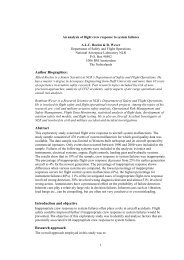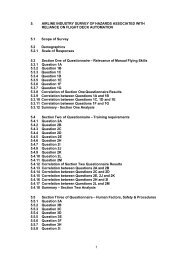Causal risk models of air transport - NLR-ATSI
Causal risk models of air transport - NLR-ATSI
Causal risk models of air transport - NLR-ATSI
You also want an ePaper? Increase the reach of your titles
YUMPU automatically turns print PDFs into web optimized ePapers that Google loves.
insurance market is strongly influenced by ‘spillover’ from the general insurance market,<br />
the financial markets and overall economy [Swiss Re 1996]. This may have a much bigger<br />
impact than the (expected) crash <strong>risk</strong> and would thus limit the usebility <strong>of</strong> a causal <strong>risk</strong><br />
model.<br />
Airlines monitor safety performance <strong>of</strong> the fleet by routinely analysing in-flight recorded<br />
data and checking parameter values for crossings <strong>of</strong> pre-defined threshold values.<br />
Individual threshold crossings are analysed to determine exactly what happened (see also<br />
section 8.5.4). In addition to this flight data program, most <strong>air</strong>lines also have a system in<br />
place for the flight crew to report abnormal situations. This information is usually in a freetext<br />
format. The combination <strong>of</strong> flight data and crew reports provide the <strong>air</strong>line with a good<br />
picture <strong>of</strong> individual incidents, but as <strong>of</strong> yet a tool that allows analysis on a more generic<br />
level does not exist. At best <strong>air</strong>lines do some sort <strong>of</strong> trend analysis. A causal <strong>risk</strong> model<br />
would be very valuable to <strong>air</strong>lines if it could support providing an overall safety picture<br />
and, most importantly, show <strong>air</strong>line management the influence <strong>of</strong> their decisions on the<br />
level <strong>of</strong> safety. It is therefore required that a causal <strong>risk</strong> model links-up with the primary<br />
safety data information systems: flight data and safety reports.<br />
A challenge for <strong>air</strong>lines is to maintain current (safety) standards in a changing world. When<br />
such changes are local and threaten to influence the ‘level playing field’ (see section 4.3.6)<br />
or their competitiveness, <strong>air</strong>line management will be keen on taking proper<br />
countermeasures to ensure pr<strong>of</strong>itability <strong>of</strong> the company. When locally imposed safety<br />
measures threaten the level playing field, the reaction will be to resist them until and unless<br />
all others are required to implement them also. Competitiveness is the driving factor. A<br />
causal <strong>risk</strong> model could play a role in analysing future changes, estimating their effect on<br />
safety and providing information that allows selection <strong>of</strong> proper countermeasures. For<br />
<strong>air</strong>lines therefore the ability to perform cost benefit analysis <strong>of</strong> proposed future changes<br />
would be a desirable feature for a causal <strong>risk</strong> model. This implies also the need for a model<br />
in which the way that future changes in how functions are operationalised can be<br />
incorporated. Because <strong>of</strong> the low accident frequency, a causal <strong>risk</strong> model for <strong>air</strong>lines should<br />
be based on safety indicators other than the accident rate.<br />
4.3.2. Rep<strong>air</strong> stations<br />
Maintenance technicians consider <strong>air</strong>craft safety to be the result <strong>of</strong> their pr<strong>of</strong>essional skills.<br />
They feel responsible for safety. In the process <strong>of</strong> releasing an <strong>air</strong>craft back into service,<br />
some maintenance technicians even think that they sign <strong>of</strong>f for the safety <strong>of</strong> the <strong>air</strong>craft<br />
rather than (as required by regulation) for having followed prescribed procedures [Biemans<br />
et al 1998]. These procedures are specified in the operator’s maintenance program, which is<br />
normally based on instructions for continued <strong>air</strong>worthiness prepared by the manufacturer.<br />
The operator may rewrite the structure and format <strong>of</strong> these maintenance recommendations<br />
to better suit his operation. Once <strong>air</strong>craft enter service, the initial maintenance program is<br />
subject to continuous development and update as modifications, product improvements and<br />
operational feedback are incorporated. To evaluate the effectiveness <strong>of</strong> the maintenance<br />
program and to update it, operators develop a reliability program. The actions resulting<br />
from the reliability program may be to escalate, de-escalate, omit or add maintenance tasks.<br />
By proving to the authority for instance that increasing a servicing or inspection interval for<br />
a particular component does not adversely affect safety, the operator could save money in<br />
maintenance expenditures. The Alaska Airlines MD-83 accident in 2000 (see infobox) is an<br />
example <strong>of</strong> a case where inspection intervals were extended without the operator (Alaska<br />
Airlines) or the authority (FAA) being sufficiently aware <strong>of</strong> the safety implications.<br />
45




